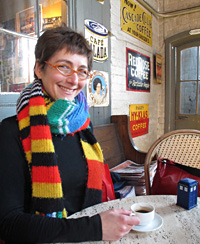I've always been pretty relaxed when it comes to the charts vs. written instructions debate. I'm pretty comfortable with either, and although I like the visual preview that you get in a chart, I don't have any problems working with written instructions.
However, I finally found a pattern that stumped me, that required me to chart out a written design.
It's a design my Mum is working on, a great textured sweater for my brother. It's a bit rough and organic looking, worked in what I'd called an off-set rib. The basis of the pattern is a k4 p2 ribbing, but after 8 rows even it shifts over stitch by stitch for 8 rows and then repeats the k4 p2 rib in a different position, and then shifts back to the original position. It's 32 rows in total, on 6x+2 sts.
The pattern stitch is written out on the pattern sheet, row by row, and it's an absolute nightmare to read and interpret. Before she started working it, I helped my Mum make some size modifications, and I spent a fair bit of time looking at the pattern overall and the pattern stitch instructions. It was still a total surprise when I saw it knitted up.
Part of the problem is that the pattern writer has taken a couple of shortcuts that make it harder to read. It makes sense that for the "base" k4 p2 sections, the RS and WS rows are written out once, and then the knitter is instructed to repeat them 3 times. Yup, easy to figure out. No problem.
But then you're working the section where the rib is moved over by 1 stitch each row. My first issues is that the rib is "moved" on both the RS and WS rows. This makes it harder to predict what you need to do. It much easier for a knitter if the WS row is simply a repeat of the patterning on the RS row. Way less chance of error. And then because you're moving over a full 8 stitches over 8 rows on a 6 stitch repeat, two of the rows are repeated.
Let me write it out for you.
Rows 1-8 are 4 repeats of:
RS: p2 [k4, p2]
WS: k2 [p4, k2]
Easy! Then it gets frustrating.
Row 9: k1, *[p2, k4]; repeat from * to last st, p1.
Row 10: *[p4, k2]; repeat from * to last 2 sts, p2.
Row 11: k3, p2, *[k4, p2]; repeat from * to last 3 sts, k3.
Row 12: p2, *[k2, p4]; repeat from * to end of row.
Row 13: p1, *[k3, p2] to last st, k1
Rows 14 to 16: Repeat rows 8 to 10.
Row 17: As row 11.
Hello???
There are two ways to make this better.
1. How about Rows 14-17: Repeat rows 8 to 11? Much simpler.
2. Or spell the damn thing out. You can see how it's not easy to figure out what the pattern stitch will produce... I honestly think that in this case, the shortcut of "repeat rows x-z" makes it worse, because you can't in advance see the pattern stitch emerging.
(And that's just the first 17 rows. There's another 15 to go.)
And my other complaint? The picture on the front of the pattern is taken from a fair distance, and the sweater is worked in a tweedy yarn.
This breaks two critical rules:
1. Make sure that the pattern stitch in clear in the pictures. That is, take the picture close enough that you can see it.
2. And make sure the pattern stitch is clear in the pictures. That is, how about a single colour yarn? What insanity possessed the knitter to work the sample in a tweedy yarn anyway?
Still, it will be lovely once it's done!
Subscribe to:
Post Comments (Atom)






No comments:
Post a Comment